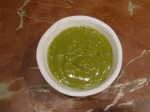 You probably already know tea is good for you. Over the past decade and even this week, studies of green, black and Oolong teas have found they are rich in antioxidants which can help stave off several cancers, including, skin, breast, lung, colon, esophageal, and bladder. The teas have also been shown to improve the health of arterial walls, lower blood pressure, reduce our risk for heart disease, lower cholesterol, prevent Alzheimer’s and reduce body weight and abdominal fat. (Sources: Harvard Health Letter, WebMD)
You probably already know tea is good for you. Over the past decade and even this week, studies of green, black and Oolong teas have found they are rich in antioxidants which can help stave off several cancers, including, skin, breast, lung, colon, esophageal, and bladder. The teas have also been shown to improve the health of arterial walls, lower blood pressure, reduce our risk for heart disease, lower cholesterol, prevent Alzheimer’s and reduce body weight and abdominal fat. (Sources: Harvard Health Letter, WebMD)
Getting the Most from Your Tea Catechins, a group of disease-fighting flavonoids and antioxidants,  are the powerhouse behind tea’s health benefits. The best way to get the catechins and other flavonoids in tea is to drink it freshly brewed from organic tea leaves. (Who needs the extra pesticides?) Decaffeinated, bottled tea drinks, and instant teas have fewer of these compounds. Steep tea for three to five minutes to bring out its catechins; the longer you steep, the more flavonoids will seep into your brew. Several studies suggest drinking at least three cups each day to get the best tea benefit.
are the powerhouse behind tea’s health benefits. The best way to get the catechins and other flavonoids in tea is to drink it freshly brewed from organic tea leaves. (Who needs the extra pesticides?) Decaffeinated, bottled tea drinks, and instant teas have fewer of these compounds. Steep tea for three to five minutes to bring out its catechins; the longer you steep, the more flavonoids will seep into your brew. Several studies suggest drinking at least three cups each day to get the best tea benefit.
 Chai – An Uber Tea
Chai – An Uber Tea Now, let’s take it up a notch. Chai tea, which comes from Ayurvedic medicine, contains many health-promoting spices that are also rich in antioxidants and anti-inflammatory properties. These include ginger, cinnamon, cloves, cardamom, black pepper and fennel. Chai is a literal antioxidant elixir. Since dairy milk is reported to block the absorption of antioxidants, I substitute almond milk in my chai recipe, below.

Edible Tea Did you know you can eat tea? I absolutely love the Tea Leaf Salad at Burma Superstar at 309 Clement St. in San Francisco. Blogger Tea & Cookies explains the salad well: “The tea leaves are fermented, apparently hand-carried back from Burma, and have a deep vegetal flavor unlike anything I’ve ever tasted before. It is mixed at the table with romaine lettuce, peanuts, fried garlic and split yellow peas, sesame and sunflower seeds, tomato, and dried shrimp… It is crunchy and crispy and the flavor is out of this world, a musky, fragrant taste I’ve found nowhere else.”
Below, I’ve attempted to recreated Burma Superstar’s recipe using all organic ingredients including the tea leaves. It’s not quite as exotic tasting as the restaurant’s fermented Burmese leaves, but it has great flavor, texture and healthfulness!
Chai (Adapted from the Culinary Institute of America Master Chefs)

3 cinnamon sticks
4 teaspoons sliced ginger (no need to peel)
1 T cardamom pods
1 1/2 t fennel seeds
1/4 t whole cloves
1/8 t black peppercorns
4 c water
12 bags or 4 t black tea leaves (traditionally Darjeeling is used)
1/4 to 1/2 c honey or to taste
4 c almond milk (or your favorite milk)
If you have a high-powered blender, grind all spices together first and place into pot with water (otherwise brew spices whole, cracking cinnamon sticks, and simmer for an additional five minutes). Boil 10 minutes, stirring occasionally (15 minutes if using whole spices). Off heat. Pour liquid through a fine mesh strainer into an 8 cup or larger Pyrex or ceramic pitcher. Stir in honey to taste. Add milk to strained tea and stir. Enjoy hot or cold.
Tea Leaf Salad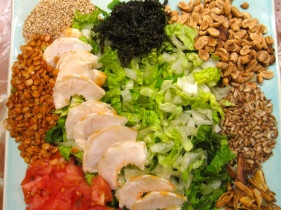
1/3 c yellow split peas
2 T olive oil
1/4 c apple cider vinegar
1/3 c green tea leaves (I used Republic of Tea’s Organic Dancing Leaves Green Tea sold bulk at Whole Foods.)
3 t Thai fish sauce (You can get this at Asian markets.)
2 T sesame oil
1/4 c sesame seeds
1/3 c sunflower seeds, unsalted
1/2 c peanuts, unsalted
2 T olive oil
8 large cloves garlic, peeled and sliced thinly lengthwise
2 T fresh lime juice
2 t cilantro, finely chopped
2/3 head of romaine lettuce, sliced into thin strips crosswise
1 small tomato or 1/2 of a large tomato, cut into small cubes
6 shrimp, precooked and shelled, sliced down the middle lengthwise
To minimize clean up, I reuse one small saucepan and one small saute pan, rinsing and wiping cleaning between uses. Place split peas into saucepan with 2/3 c water. Bring to boil and then immediately turn down to simmer. Simmer for 10 minutes or until water has evaporated. Pour 2 T olive oil in saute pan. Add peas to oil and saute for 5 minutes. Turn peas out onto paper towel placed on a dish to drain. Rinse and reuse your saucepan to cook the tea leaves, the apple cider vinegar and 2 of the teaspoons of fish sauce. Bring to boil, lower heat and simmer for 5 minutes to soften tea leaves. Drain any remaining liquid out into sink. Rinse and reuse your saute pan adding the sesame oil. Put tea leaves into saute pan and saute for 5 minutes. Turn leaves out onto second paper towel to drain. In clean, dry saute pan toast individually the sesame seeds, sunflower seeds and peanuts until lightly browned. Pour each into individual small bowls when done. Next, place the olive oil into this saute pan and saute garlic slices until browned on both

sides being careful not to burn. Off the heat and remove garlic with slotted spoon onto paper towel, keeping the oil in the pan.
To make the dressing: To the hot oil in the pan combine lime juice, the last 1 t fish sauce and cilantro.
To assemble the salad for presentation: On a platter, place lettuce strips in center. Arrange shrimp slices on top of lettuce. Group each item separately around platter–yellow peas, sesame seeds, sunflower seeds, peanuts, tea leaves, garlic, and tomatoes. Pour dressing over lettuce. Toss it at the table, combining all ingredients.
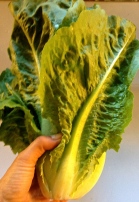
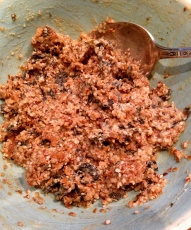


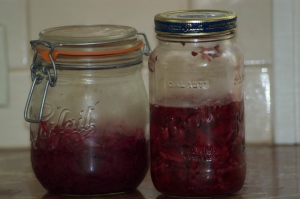
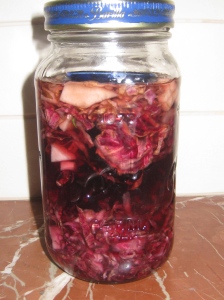



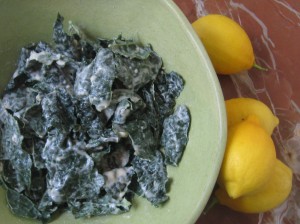










 By now we all know the benefits of eating well to build immunity and prevent disease. We may also be familiar with the benefits of phytochemicals and antioxidants–found abundantly in brightly colored fruits and vegetables–and their ability to bind to oxygen-free radicals in our bodies to prevent potential cancer-causing oxidation. Now, recent research reveals a completely new and exciting cancer-fighting potential of certain healthful foods…the ability to starve cancer cells by stopping angiogenesis (the proliferation of blood
By now we all know the benefits of eating well to build immunity and prevent disease. We may also be familiar with the benefits of phytochemicals and antioxidants–found abundantly in brightly colored fruits and vegetables–and their ability to bind to oxygen-free radicals in our bodies to prevent potential cancer-causing oxidation. Now, recent research reveals a completely new and exciting cancer-fighting potential of certain healthful foods…the ability to starve cancer cells by stopping angiogenesis (the proliferation of blood 
